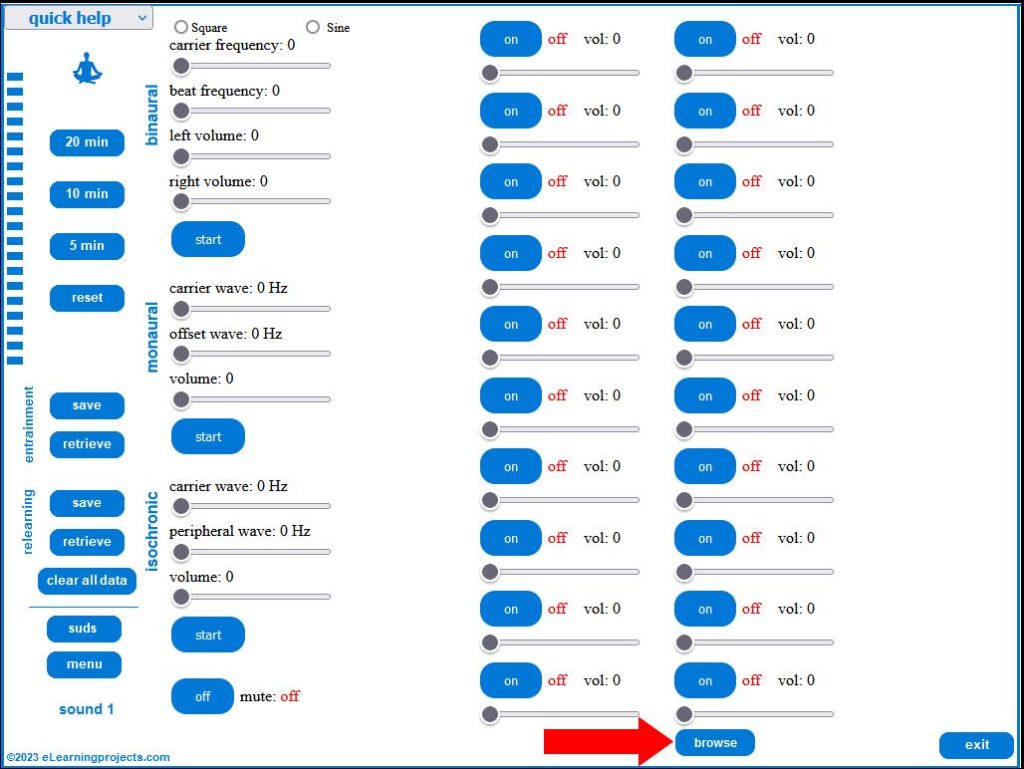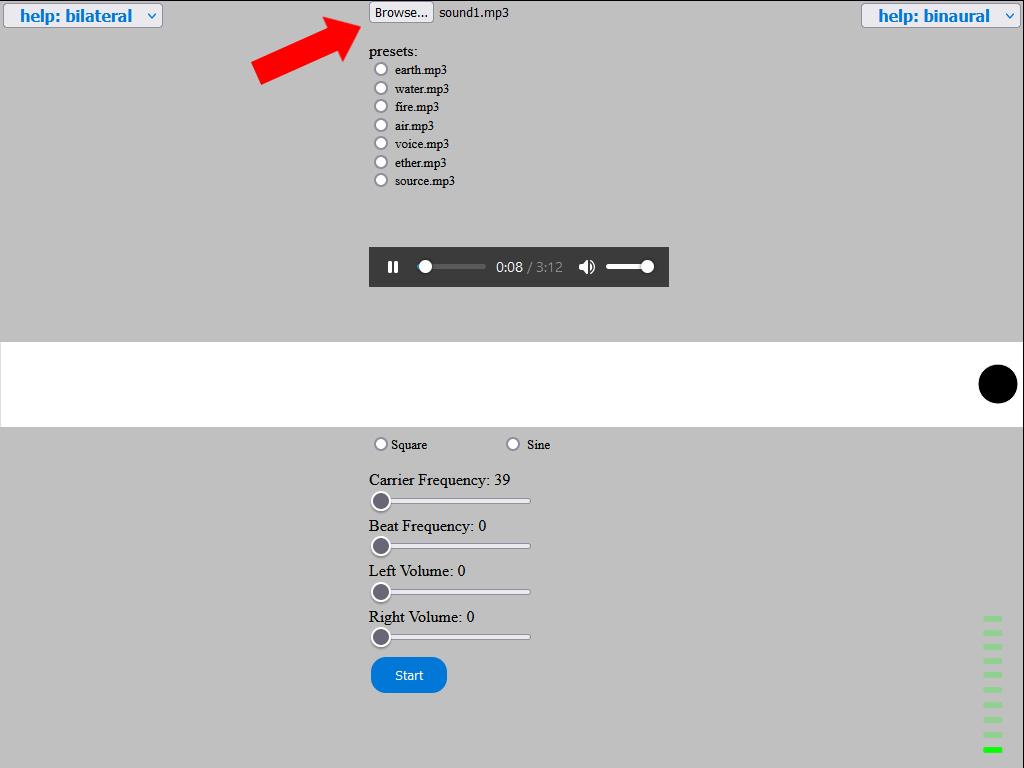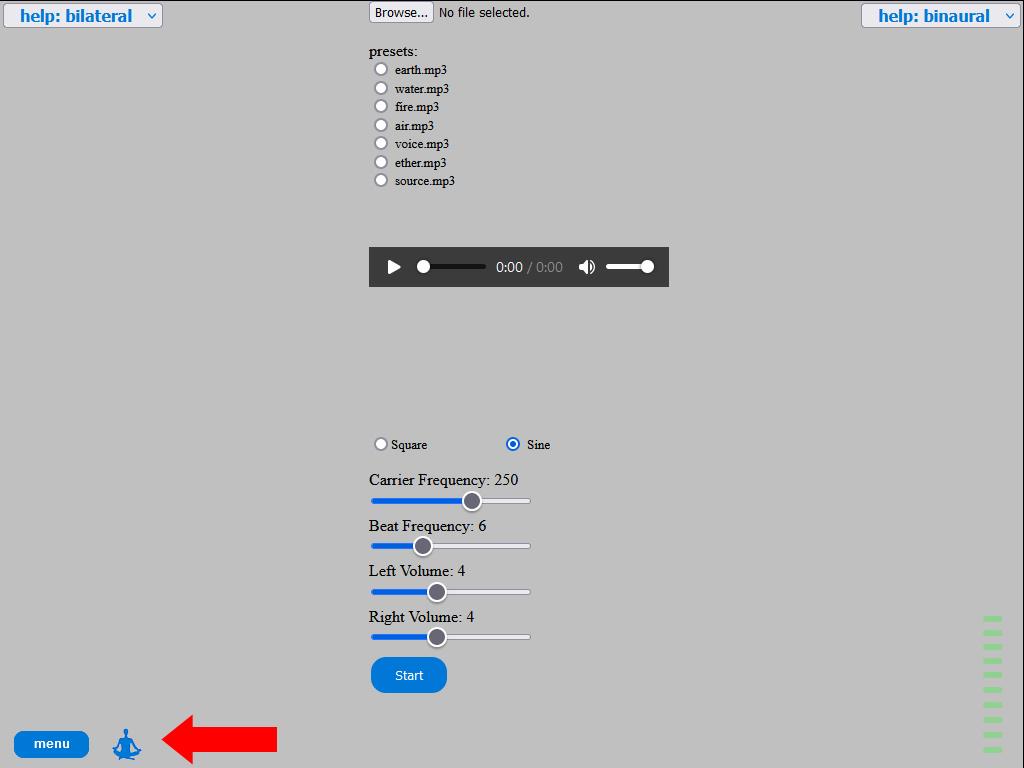TRP Applied to Sound
When we play a sound tone through stereo headphones, we hear it through both our left and right ears. If the tone is within a specific range and the difference between its left ear and right ear frequencies is within another specific range, our brain can detect the difference, and we hear a binaural beat. Binaural beats create an auditory illusion, sounding like a rhythmic beat. Sustained listening to binaural beats influences our brain, producing associated brain waves. Neuroscientists mention two possible synchronization mechanisms, entrainment and interhemispheric coherence (Garcia-Argibay et al., 2019, p 358). Binaural beats reportedly “can affect mood, performance on vigilance tasks, and anxiety” (Le Scouarnec et al., 2001).
Research has been done on these effects. These have shown that Binaural beats have been used in a wide-range of exercises to reduce pain perception and anxiety (Garcia-Argibay et al., 2019) as well as to promote relaxation, meditation (Jirakittayakorn & Wongsawat, 2017) and healing. For example, binaural beats have been used to reduce anxiety in patients undergoing (1) day surgery so they can be “street ready” quickly following the procedure (Padmanabhan et al., 2005) and (2) dental surgery (Isik et al., 2017). Both report significant anxiety reduction in pre-operative patients. However, remaining uncertainty about mechanisms and efficacy indicate a need for further research (Orozco Perez et al., 2020). The following strategies are presented with this caveat in mind.
Reconsolidation-Based Sound Model
Reconsolidation Enhancement by Stimulation of Emotional Triggers (RESET) is a reconsolidation-based treatment model that uses binaural beats to target PTSD. While binaural beats are usually generated as “sine” waves which have a pleasant sound, RESET uses a “square” wave pattern to generate binaural beats, creating a grating sound. RESET developed by Lindenfeld and colleagues (Bruursema & Lindenfeld, 2015; Lindenfeld et al., 2019a, Lindenfeld et al., 2019b; personal communication, September 6, 2020, Lindenfeld et al., 2020, Lindenfeld et al., 2021), integrates neurofeedback into a reconsolidation protocol.
RESET uses a neurofeedback hardware device (Bio-Acoustical Utilization Device or BAUD) supplemented by measuring equipment to map the brain (for example, surface qEEG and LORETA analysis, Lindenfeld et al, 2019a) to determine the brain’s emotional frequencies, identifying the unique frequency activated and locked into place by the initial traumatic experience. RESET employs silent recall of the traumatic event to reactivate the locked frequency. Details of the event are not verbally shared, so the exercise, if facilitated by a helper, is “contentless.” A way to view this process: once the binaural beats are entrained to the reactivated brain frequency, a TRP mismatch is set in motion by changing this entrained binaural sound to one with less painful associated emotions. This unlocks and resets the reactivated frequency, triggering reconsolidation, resulting in symptom relief.
CT has an in-depth explanation of how a similar process meets TRP through “dual focus” in NLP (Ecker, 2015). Ecker hypothesizes that in a group of therapies including NLP, tapping and progressive counting, attention is anchored to a sensory stimulus in a safe, external environment while the person attends internally to upsetting emotional learning, triggering critical emotional learning through this juxtaposition and mismatch, causing the new emotional learning (Ecker, 2015).
A binaural beats exercise, in my view, utilizes a similar therapeutic process. Additional fMRI-based research is needed to refine understanding of these mechanisms (Lindenfeld, personal communication, September 6, 2020). However, while the hypothesis to explain these underlying mechanisms is in “early days,” needing refinement, end results demonstrate efficacy. The core mechanism triggering memory reconsolidation, an empirically confirmed process of annulment (ECPA, Ecker & Vaz, 2022) is likely present.
Weighing pros and cons: for people already suffering from (1) intrusive, unbidden re-living of trauma or (2) circumscribed life-styles due to a phobia, potential benefits of a helping protocol that includes re-experiencing a troubling event, coupled with available safeguards plus stress reduction can be weighed against a time-limited emotional upset.
While binaural, isochronic and monaural beats have all been used as sources in recent times, music has been used for millennia to promote relaxation, reduce stress and heal. Music therapy, an outgrowth of this traditional use of music, can, for example, empathically begin with music attuned (entrained) to a person’s thoughts and feelings and gently alter these by introducing different music (Leone, 2023).
Music therapy strategies that invite the person helped to choose their own sounds and music improve the likelihood that these will match targeted memories and emotions (Raglio, 2023). The self-administered exercises available in the web application’s sound tools use similar processes. For example, in addition to choosing and adjusting binaural, isochronic and monaural sound frequencies and embedding these in pre-set music, a person can upload their own music in which to embed frequencies, using the browse button (bottom right).

The image below illustrates combined audio visual exercises (the top, a bilateral sound synchronized with animated side-to-side dots for saccadic viewing; the bottom, a binaural sound synchronized with animated side-to-side dots for saccadic viewing). The top, bilateral exercise includes a browse button for the user to add their music/sound choice (see EMDR+ by Grifoni et al. 2023), or the user can pick a preset “Chakra” sound.

In the bottom, binaural exercise the user can adjust their own settings or select a “calm” Sine wave setting.

Helpful Hint: If you view the sound tool using a Chrome browser, you can save your frequency and music choices in an mp3 file (up to 20 minutes recording) and download for later re-play. To do this, download/add the free Audio Capture extension to your Chrome browser.
Research
A mega study of brain wave-sound entrainment has yielded mixed results with the authors noting that “methodological heterogeneity” between studies may make it difficult to compare their outcomes. Their proposed solution: methodological standardization (Ingendoh, Posny & Heine, 2023).
Small-sample research studies have demonstrated initial efficacy of RESET therapy (Lindenfeld et al., 2019a: Lindenfeld et al., 2019b, Lindenfeld et al., 2020, Lindenfeld et al., 2021) with the caution that follow-up will be needed to check if positive changes are maintained. It is hypothesized that reconsolidation and not extinction is produced using this protocol. Progress achieved by extinction would be partial and temporary, not maintained over time (Ecker & Bridges, 2020). So, as the authors suggest, follow-up would be helpful to check if gains endure (Lindenfeld et al., 2019a, Lindenfeld et al., 2019b; personal communication, September 6, 2020). Specialized training for RESET Therapy and the BAUD is available.
For people with disorders affecting their seizure threshold, they would need to observe cautions and consult with a healthcare professional before using sound- based exercises (Ellis, 2017) or visual exercises.
References
Bruursema, L. Richard & Lindenfeld, George. (2015). Resetting the Fear Switch in PTSD: A Novel Treatment Using Acoustical Neuromodulation to Modify Memory Reconsolidation. DOI:10.13140/RG.2.1.4695.9446.
Ecker, B. (2015). Using NLP for memory reconsolidation: A glimpse of integrating the panoply of psychotherapies. The Neuropsychotherapist, 10, 50–56.
Ecker, B., Bridges, S.K. (2020). How the Science of Memory Reconsolidation Advances the Effectiveness and Unification of Psychotherapy. Clin Soc Work J (2020).
Ecker, B. & Vaz, A. (2022). Memory reconsolidation and the crisis of mechanism in psychotherapy. New Ideas in Psychology, 66 (2022), Article 100945.
Ellis, L. (2017). The potential mechanism of musicogenic epilepsy and future research avenues, Bioscience Horizons: The International Journal of Student Research, Volume 10, 2017, hzx004, https://doi.org/10.1093/biohorizons/hzx004.
Garcia-Argibay, M., Santed, M.A. & Reales, J.M. (2019). Efficacy of binaural auditory beats in cognition, anxiety, and pain perception: a meta-analysis. Psychological Research 83, 357–372 (2019). https://doi.org/10.1007/s00426-018-1066-8.
Grifoni, J., Pagani, M., Persichilli, G., Bertoli, M., Bevacqua, M.G., L’Abbate, T., Flamini, I.,
Brancucci, A., Cerniglia, L., Paulon,L., et al. Auditory Personalization of EMDR Treatment to Relieve Trauma Effects: A Feasibility Study [EMDR+]. Brain Sci. 2023, 13, 1050. https://
doi.org/10.3390/brainsci13071050.
Ingendoh, R.M., Posny, E.S., Heine, A. (2023). Binaural beats to entrain the brain? A systematic review of the effects of binaural beat stimulation on brain oscillatory activity, and the implications for psychological research and intervention. PLoS ONE
18(5): e0286023. https://doi.org/10.1371/journal.pone.0286023.
Leone, R. (2023, August 25). ON YOUR MIND. Music can serve as therapy. Here’s how it can reduce anxiety. Washington Post. https://www.washingtonpost.com/wellness/2023/08/25/music-therapy-reduce-anxiety-strategies/
Le Scouarnec, R. P., Poirier, R. M., Owens, J. E., Gauthier, J., Taylor, A. G. & Foresman, P. A. (2001). Use of binaural beat tapes for treatment of anxiety: a pilot study of tape preference and outcomes. Alternative Therapies in Health and Medicine 2001; 7: 58–63.
Lindenfeld, G., Rozelle, G., Hummer, J., Sutherland, M. R., & Miller, J. C. (2019a). Remediation of PTSD in a combat veteran: A case study. NeuroRegulation, 6(2), 102–125. https://doi.org/10.15540/nr.6.2.102.
Lindenfeld, G., Rozelle, G., Soutar, R., Hummer, J., & Sutherland, M. (2019b, Winter). Post-traumatic stress remediated: A study of eight combat veterans. New Mind Journal. Retrieved from http://nmindjournal.com/post-traumatic-stress-remediated-a-pilot-study-of-8-combat-veterans/.
Lindenfeld, G. L., Hummer, J.T. and Billiot, K. (2021). Anger and Aggression: A New Beginning? Family Court Review, 59: 161-170. https://doi.org/10.1111/fcre.12538
Jirakittayakorn, N. & Wongsawat, Y. (2017). Brain Responses to a 6-Hz Binaural Beat: Effects on General Theta Rhythm and Frontal Midline Theta Activity. Front. Neurosci. 11:365. doi: 10.3389/fnins.2017.00365.
Orozco Perez, H. D., Dumas, G. & Lehmann, A. (2020). Binaural Beats through the Auditory Pathway: From Brainstem to Connectivity Patterns.eNeuro.2020;7(2): ENEURO.0232-19.2020. Published 2020 Mar 19. doi:10.1523/ENEURO.0232-19.2020.
Padmanabhan, R., Hildreth, A. J., & Laws, D. (2005). A prospective, randomised, controlled study examining binaural beat audio and pre-operative anxiety in patients undergoing general anaesthesia for day case surgery. Anaesthesia, 60(9), 874–877. https://doi.org/10.1111/j.1365-2044.2005.04287.x.
Raglio, A. (2023). A novel music-based therapeutic approach: the Therapeutic Music
Listening. Front. Hum. Neurosci. 17:1204593. doi: 10.3389/fnhum.2023.1204593
 Loading
Loading